Occupational environment monitoring of a footwear manufacturing factory
99,000 ₫
Note: The above price is calculated for one sample, and the price may fluctuate depending on the area of the environment to be monitored and market movements. For more accurate pricing support, please refer to the price list or contact our consulting staff directly.
Monitoring the environment of a footwear manufacturing factory is a session of collecting, analyzing, and evaluating factors at the workplace that may harm workers health.
Table of Contents
Toggle1. Overview of Footwear Factories
a. What is a Footwear Factory?
A factory producing footwear is a production facility specialized in manufacturing various types of shoes, sandals, and related products. This factory is equipped with machinery, equipment, and complex production processes to create footwear products from materials such as leather, fabric, rubber, plastic, and other materials.
Footwear factories can specialize in producing sports shoes, industrial shoes, fashion shoes, sandals, flip-flops, and many other types of products.

b. Production Stages in a Footwear Factory
Production stages in a footwear factory usually include the following phases:
- Design and Development: The design department creates new shoe models based on customer requirements and market trends. The shoe designs are developed into detailed technical drawings and prototypes.
- Material Preparation: Materials for footwear production such as leather, fabric, rubber, plastic, accessories, and other components are prepared. Materials are quality-checked and cut into parts such as soles, shoe uppers, heels, and laces.
- Main Processing: The parts of the shoes are processed through cutting, sewing, gluing, attaching, pressing, printing, and embroidery. This stage produces the shoe components ready for assembly.
- Assembly: The shoe components are assembled together. Typically, the assembly process includes sewing, attaching, gluing, or using specialized machines and technologies to ensure secure bonding.
- Finishing: After assembly, shoes undergo finishing processes such as cleaning, polishing, dyeing, printing logos or patterns, and adding additional details like zippers, hooks, or decorative materials.
- Quality Inspection: Finished shoes are inspected to ensure they meet quality standards and customer requirements. Inspections may include technical testing, durability testing, hygiene checks, and visual inspections.
- Packing and Shipping: After passing quality inspection, shoes are packed and prepared for delivery to retail outlets or distributors.
These stages may vary depending on the type of footwear, production scale, and specific processes of each footwear factory.

c. Types of Machinery Used in a Footwear Factory
Footwear factories use various machinery and equipment to carry out production stages. Below are some common machines used in the footwear industry:
- Leather and Fabric Cutting Machines: Used for accurately cutting shoe components from leather and fabric.
- Stamping and Pressing Machines: Used to stamp and press shoe components such as soles, heels, and toe caps.
- Sewing Machines: Industrial sewing machines are used to stitch shoe parts together, including single-needle, double-needle, and computerized sewing machines.
- Gluing Machines: Use specialized adhesives and machines to bond shoe components together.
- Shaping Machines: Used to shape components such as soles, heels, and toe caps.
- Printing and Embroidery Machines: Used to print or embroider patterns, logos, letters, or decorative details on the shoe surface.
- Sole Molding Machines: Used to produce shoe soles from materials like rubber, plastic, or composite materials.
- Heat Press Machines: Used to bond shoe components using heat and pressure to secure the adhesive.
- Polishing and Cleaning Machines: Used to polish and clean shoe components for a finished surface.
- Quality Inspection Equipment: Includes machines and tools to inspect shoe quality, such as measuring dimensions, testing durability, friction, adhesion, etc.
These are just examples of commonly used machinery in footwear factories. The scale and technology may vary depending on the production process and type of footwear product.

d. Occupational Diseases for Workers in Footwear Factories
Workers in footwear factories may suffer from several occupational diseases due to work factors and environmental conditions. Common occupational diseases in the footwear industry include:
- Respiratory Diseases: Workers may be affected by chemicals used in production such as adhesives, cleaning agents, and leather softeners, causing rhinitis, pharyngitis, breathing difficulties, cough, and other respiratory issues.
- Skin Allergies: Contact with leather, adhesives, chemicals, and additives may cause skin allergies. Symptoms include dermatitis, itching, rashes, redness, and swelling.
- Musculoskeletal Disorders: Prolonged work and use of tools and machinery can stress bones, muscles, and joints, leading to back pain, neck pain, arthritis, and other musculoskeletal problems.
- Nervous System Disorders: Exposure to chemicals may affect the nervous system, causing dizziness, insomnia, or even neurological damage leading to tremors or involuntary movements.
- Hand and Wrist Disorders: Tasks involving knives, scissors, and cutting machines can cause injuries and disorders such as tendonitis, ligament inflammation, and wrist joint degeneration.
- Mental Health Issues: Work pressure, increased production demands, and fast-paced environment can cause stress, anxiety, depression, and other mental health issues.

e. Types of Products in a Footwear Factory
Footwear factories produce various products based on market demand and trends. Common products include:
- Sports Shoes: Includes running shoes, football shoes, tennis shoes, walking shoes, golf shoes, and other sports shoes.
- Industrial Shoes: Designed for safety in industries such as construction, hazardous environments, stiff material handling, and anti-static requirements.
- Fashion Shoes: Includes high heels, pointed shoes, flats, boots, platform shoes, oxford shoes, and other fashionable footwear.
- Children’s Shoes: Shoes specifically for children, including running shoes, sports shoes, school shoes, beach shoes, and sizes appropriate for children.
- Sandals and Flip-Flops: Includes indoor slippers, beach sandals, thong sandals, foam sandals, and traditional sandals.
- Sandals: Includes women’s, men’s, and children’s sandals for casual or beachwear.
- Dress Shoes and Ballet Flats: Designed for women, including high heels, platform shoes, stiletto heels, and cute ballet flats.
- Specialty Shoes: Includes trail running shoes, hiking shoes, walking shoes, marathon shoes, camping shoes, and shoes for specific sports or environments.
These are examples of product types in footwear factories. Factories may produce many different products depending on market and customer requirements.

2. Overview of Occupational Environment Monitoring Services
a. What is Occupational Environment Monitoring in Footwear Factories?
Occupational environment monitoring (or workplace environment measurement) in footwear factories is the activity of collecting, evaluating, and analyzing measurement indicators of workplace environmental factors in the factory, to implement timely measures, minimize environmental harm to workers’ health, and prevent occupational diseases. Occupational environment monitoring is a mandatory regulation for footwear factories.
Occupational environment monitoring plays a crucial role in protecting, maintaining, and enhancing workers’ health, as the main resource of a business and the direct source of profit is the workforce. Workers frequently exposed to risk factors exceeding permissible limits may experience health impacts and develop occupational diseases.
REGISTER FOR OCCUPATIONAL ENVIRONMENT MONITORING SERVICE
b. Nam Viet Occupational Environment Monitoring Program
Nam Viet’s occupational environment monitoring program is developed by monitoring engineers specialized in occupational safety and environmental protection. Aiming to ensure health and safety for workers, the program uses modern measurement methods to monitor air quality, water, microclimate, physical factors, dust, and other workplace environmental conditions. This program is vital for maintaining a safe working environment and protecting workers’ health.
Additionally, Nam Viet’s program is important for researching and developing new solutions to improve occupational environment quality. With a dedicated and professional team of monitoring experts, Nam Viet’s exclusive monitoring program is becoming a breakthrough in occupational safety and environmental management in Vietnam.

c. Standardization in Occupational Environment Measurement Procedures
Standardization in Nam Viet’s occupational environment measurement procedures is essential to ensure accurate and reliable results. The program applies recognized standards and standardized procedures from the Ho Chi Minh City Department of Health. This ensures that collected data can be used reliably for evaluating workplace conditions and making decisions to improve occupational health protection.
These standardized procedures also ensure that measurements are performed by highly qualified monitoring specialists with years of experience, enabling managers and experts to trust Nam Viet’s results and make accurate, valuable decisions to protect workers’ health and the environment.
By applying standardized measurement procedures, Nam Viet demonstrates its commitment to ensuring a safe working environment and protecting workers’ health, while contributing positively to the development and enhancement of occupational safety and environmental management in Vietnam.
d. Footwear Factory Monitoring Report
Occupational environment monitoring results are compiled according to Form No. 04, Appendix III issued with Decree 44/2016/ND-CP and prepared in two copies: one sent to the contracted workplace and one retained by the monitoring organization.
Monitoring records are kept indefinitely in accordance with legal regulations.

e. Frequency of Occupational Environment Monitoring as Required by Law
According to Clause 2 of Article 18, Law on Occupational Safety and Hygiene 84/2015/QH13, employers must organize occupational environment monitoring to evaluate harmful factors at least once per year.
f. Deadline for Submitting Occupational Environment Monitoring Reports
The deadline for submitting reports is before December 31 each year. Enterprises in production facilities must submit occupational environment monitoring reports to the local Department of Health where the business is headquartered and where workers are employed.
When there are changes in technology, production processes, or upgrades that may introduce new hazardous factors, enterprises must update occupational hygiene records regarding harmful factors that require monitoring.
g. Penalties for Violations of Occupational Environment Monitoring by Employers
According to Article 27 of Decree No. 12/2022/ND-CP dated January 17, 2022, regulating administrative penalties in labor, social insurance, and Vietnamese workers working abroad under contracts:
- Clause 2: Fines from 2,000,000 – 5,000,000 VND for employers who fail to publicly announce monitoring results and hazard assessments to workers at the monitored site and evaluation locations immediately after results are available.
- Clause 3: Fines from 20,000,000 – 40,000,000 VND for employers who fail to conduct occupational environment monitoring to control health hazards as required by law.
- Clause 4: Fines from 40,000,000 – 60,000,000 VND for employers who collude with monitoring organizations to commit fraud in occupational environment monitoring activities but do not reach the level of criminal liability.
3. Harmful Environmental Factors for Workers in Shoe Factories
In shoe factories, there are several harmful environmental factors that can affect workers’ health. Here are some common harmful environmental factors:
- Dust and chemical fumes: Processes such as cutting, stamping, sewing, and finishing in shoe factories can generate dust and fumes from materials like leather, fabric, adhesives, and chemicals used in production. Long-term exposure to this dust and fumes may irritate eyes, nose, throat, respiratory system, and skin.
- Chemicals: During shoe production, chemicals such as adhesives, solvents, detergents, and leather softeners are used. Exposure to these substances can cause skin allergies, irritation, and potential health hazards.
- Noise: Machinery and equipment in shoe factories can produce high noise levels. Continuous exposure to noise can harm hearing and cause psychological stress.
- Temperature and humidity: Some production processes in shoe factories require specific temperature and humidity conditions. Working in environments that are too hot, cold, or humid can cause discomfort, fatigue, and affect workers’ health.
- Lighting: Work in shoe factories often requires adequate lighting for accurate tasks and quality inspection. However, glare, dim lighting, or insufficient lighting can cause eye strain, difficulty focusing, and work challenges.
- Physical hazards: Work in shoe factories may involve using tools and machines such as knives, scissors, cutting machines, and heat presses, which carry the risk of injury.
REGISTER FOR OCCUPATIONAL ENVIRONMENT MONITORING SERVICE
4. Measures to Improve Working Conditions in Shoe Factories
To improve working conditions in shoe factories and protect workers’ health, the following measures can be applied:
- Ensure ventilation and exhaust: Provide effective ventilation systems and exhaust fans to remove dust and chemical fumes during production. This helps reduce respiratory irritation and protect workers’ health.
- Use personal protective equipment: Ensure workers properly use personal protective equipment such as masks, gloves, safety glasses, and dust-preventive clothing. This helps reduce exposure to harmful dust and chemicals.
- Ensure proper lighting: Provide adequate and appropriate lighting in work areas to reduce eye strain and improve work performance. Use natural light or soft, glare-free lighting to create a comfortable and safe working environment.
- Training and education: Train employees on safety measures, correct work procedures, and use of protective equipment. Raise awareness of risks and prevention of occupational diseases, and encourage personal protective measures.
- Chemical management: Ensure proper storage, use, and transport of chemicals in shoe factories according to safety regulations. Minimize the use of harmful chemicals and replace them with safer, environmentally-friendly substances.
- Noise management: Apply measures to reduce noise in shoe factories, including soundproofing equipment and regular maintenance of machinery to lower noise levels.
- Periodically conduct occupational environment monitoring in factories, collect and analyze harmful factors affecting workers, and adjust measures to reduce risks to prevent occupational diseases for employees.
5. Benefits of Regular Shoe Factory Monitoring
An Toan Nam Viet provides businesses with excellent benefits when using occupational environment monitoring services according to Decree 44/2016/ND-CP on managing and controlling harmful factors in the workplace affecting workers.
- Businesses can proactively control harmful factors in workshops or factories.
- Receive recommendations to reduce harmful factors and improve workplace environment quality.
- Indirectly protect human resources, a key factor in business development.
- Reduce the impact of occupational diseases on workers’ health, lowering future treatment costs.
- Improve workers’ health, ensuring product quality and consistent output.
- Comply with labor safety regulations and avoid legal risks.
- Enhance reputation and professionalism, elevating the business’s brand.
Nam Viet’s occupational environment monitoring service is a solution to minimize occupational disease risks, contributing to a healthy and high-quality working environment.

6. National Occupational Environment Monitoring Center
Nam Viet Occupational Environment Monitoring Center is a professional unit specializing in supervising and measuring workplace environmental quality throughout all provinces in Vietnam. With an experienced team of monitoring specialists, the center uses modern measurement equipment to ensure accuracy and reliability.
In addition to monitoring services, the center assists clients in planning, handling, and tracking occupational environment issues. Following the motto “customer-centered,” the center prioritizes client satisfaction, meets all needs, and provides the best solutions for businesses.
REGISTER FOR OCCUPATIONAL ENVIRONMENT MONITORING SERVICE
With investments in technology, equipment, and workforce, Nam Viet’s monitoring center has become one of the most reputable units in occupational environment monitoring in Ho Chi Minh City with the following objectives:
- We always value brand reputation and the quality of our services.
- We provide clients with the best and most suitable solutions possible.
- Alongside a team of experienced Masters and Engineers, we aim to protect the environment and benefit businesses.
- Working with Nam Viet Environmental Monitoring, companies receive professional service from experts and the best cost advantages.
The occupational environment monitoring process at Nam Viet includes the following steps:
- Before monitoring, all equipment is calibrated and compliant with legal regulations.
- Carry out the monitoring process fully and correctly as committed to the Department of Health.
- Accurately report monitoring results to employers.
- If results indicate unsafe conditions, Nam Viet provides corrective solutions, and the facility implements the following:
- Implement measures to improve working conditions, minimizing harmful factors and preventing occupational diseases.
- Organize health checkups to detect occupational and work-related diseases early for employees in unsafe positions.
- Provide material support to employees according to labor law regulations.

7. Pricing for Occupational Environment Monitoring
To help businesses carry out occupational environment monitoring professionally and effectively, Nam Viet provides clients with a detailed and reasonable price list for monitoring services.
- The price list provides detailed information about costs of monitoring services, including transportation, measurement, analysis, and reporting. Clients can trust the accuracy and reliability of the reports.
- We always offer competitive and reasonable prices and are ready to answer all inquiries quickly and professionally.
- With Nam Viet’s price list, clients can easily select service packages that suit their needs. We commit to delivering maximum satisfaction with professional service quality.
1 review for Occupational environment monitoring of a footwear manufacturing factory
No comments yet


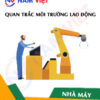
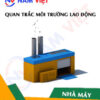
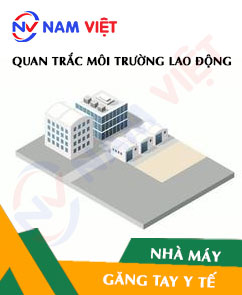




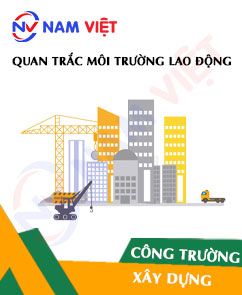
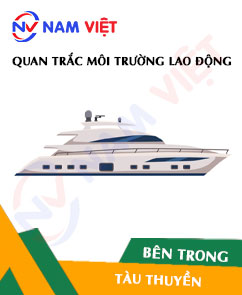
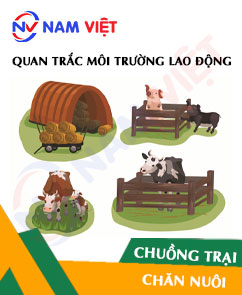
maituyet.cuong12
Good labor environment monitoring service!